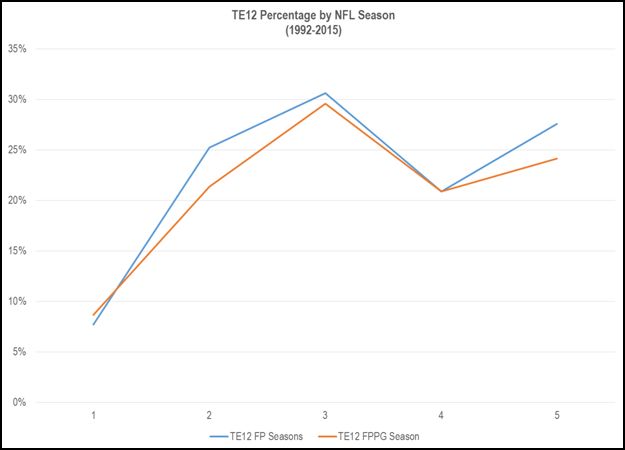The No TE Book: Why Drafting Rookie TEs is a Bad Idea
If I didn’t know better, I would say Nicholas Sparks is a fantasy football player based on what little I know about The Notebook. The tears during a rainstorm seem awful close to the shower cries owners have had after heartbreaks of past loves like Trent Richardson or Montee Ball.
Every year, we inevitably see a few tight ends drafted in the first three rounds of the NFL draft, ultimately positioning them as late first to late second dynasty rookie draft picks in many drafts. Some owners, however, avoid them completely. They see tight ends as a longer term investment due to their inability to contribute early.
For this study, we will be looking at the timeframe of 1992 (the first year Pro Football Reference has target data available) through 2015. Additionally, we will only focus on tight ends drafted in the first three rounds in the draft, which encompasses 111 drafted players during the aforementioned timeframe. Last, a player is only counted in a given year if he had at least one target during the season.
[am4show have=’g1;’ guest_error=’sub_message’ user_error=’sub_message’ ]
Raising the Bar
We will look at the rate tight ends become starting contributors a bit later, but there is a reason beyond simply the development timeline of individual tight ends. Bluntly, it is the increased scoring threshold at the position. Over the twenty four year period examined in this study, there are several phases of startable tight end production (represented in the chart below). The first occurs from 1992-2004 where surpassing 100 fantasy points typically resulted in a starting tight end in a twelve team league. From 2005-2008, the TE12 minimum rose to roughly 125 points in a season. Now, over the past seven years, that number is closer to 150 fantasy points, 50% higher than what we saw at the beginning of the study. Fantasy points per game, shown with the red line and plotted on the secondary y-axis (on the right side), has a similar trend.

What this means is that it has become increasingly harder for a rookie to become a startable asset in his first year. While most rookies are not drafted to be starters for your fantasy team right away, this trend holds true whether we measure the twelfth or the twenty fourth tight end over time.
When looking at the full list of rookie tight ends over the 24 year period, only eight of the 104 tight ends who received a target managed to finish as a top twelve tight end in total fantasy points (just nine finished in the top twelve based on fantasy points per game). Within each of these groups, just one occurred during the post-2009 timeframe which defines the current period.

The players listed are a mixed bag of elite level tight ends and players who stumbled upon a team in need of immediate contribution. Considering only one tight end has surpassed 100 targets his rookie season (Jeremy Shockey) and one has scored more than six touchdowns (Rob Gronkowski), the odds are stacked against an early return on investment.
Consider this: we are seeing roughly one rookie tight end drafted in the first three rounds deliver a starting season for a fantasy team (7.6% probability). Running backs and wide receivers average approximately one per season, with a higher probability of occurrence relative to total drafted in first three rounds (13.6% and 8.2%).
Time Value of Tight Ends
So if I am advising the avoidance of rookie tight ends, when is the time to pounce on the player you like? Well, one thing we know is that a rookie on average, will stay put or increase in value between year one and year two (via Ryan McDowell). We also know that based on the 2013 draft class, we saw more lose value and less gain value before year three versus prior to year two (more Ryan).
A few new things to add into this past analysis, specifically in regards to tight ends. First, let us take a look at the probability a tight end becomes a top 12 option in each of his first five years. The below chart displays this:

The largest positive shift occurs between year one and year two, where the likelihood of a top 12 tight end season grows from 8% to 25% while it is slightly more modest when looking at fantasy points per game (9% to 21%). This growth suggests a clear window where taking a chance on a less productive, but talented, rookie tight end is more likely to pay off. Buying after year two appears to be too late, with little growth in tight end success rate, which is primarily a result of some tight ends ending their NFL careers.
While production can tell you when to buy before a breakout, are owners already keen on the trend? Roughly half of all tight ends (see table below) gain value of at least one round when comparing ADP year over year. This is higher than what happens after year two but similar to year three. Meanwhile, only 17% lose value after their rookie year, lower than what we see the next two years.

This does seem to contradict the idea of not drafting rookies and waiting until their first off-season. Instead, this should encourage you to buy any of these early NFL draftees who have not raised in value after year one, knowing it will cost the same price (or hopefully lower) and the odds of success are higher.
Ploy or Deploy?
If you are still reading, it means you care (a little) about the tight end position. This will never be a glamour position, but gaining incremental advantages is how you win in a competitive league. By playing the waiting game with young tight ends, and potentially pairing them with a cheaper veteran option, any hit you make will create a long-term solution or even a future trade chip.
[/am4show]
- Bowl Game Previews: CFB Playoff Semifinals - December 28, 2018
- The Narrative Fallacy and How it Compels Us - May 13, 2017
- 2017 NFL Draft – College Wide Receiver AIR - April 27, 2017

































































